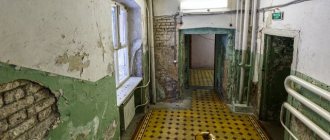The Supreme Court found it impossible to remove the house from the targeted program for relocation from dilapidated housing
In Ruling No. 48-CAD20-12-K7 dated January 27, the Supreme Court examined whether it is possible to withdraw an apartment from the regional targeted program and refuse to provide housing in place of emergency housing.
Zoya Osolodkova is the only heir of her mother, who, until her death on May 5, 2007, was the owner of an apartment in an apartment building.
Based on the conclusion of the interdepartmental commission recognizing the residential building as unsafe and subject to demolition and the inspection report of the apartment building dated December 7, 2011, the residential building was recognized as unsafe and subject to demolition. The property is included in the list of emergency apartment buildings located on the territory of the Plastovsky municipal district and included in the regional targeted program “Resettlement of citizens from emergency housing stock in cities and districts of the Chelyabinsk region in 2013–2017.” By decree of the administration of the municipal district, the house was included in the municipal program “Resettlement in 2015 of citizens from emergency housing stock in the territory of the Plastovsky municipal district.”
On December 30, 2021, the district administration decided to seize residential premises in connection with the seizure of a land plot under an apartment building. Zoya Osolodkova was denied the provision of residential premises to replace the seized emergency housing, since the administration did not have legal grounds for this. Moreover, according to the certificate of the right to inheritance by law, the woman is the owner of this apartment, which is also confirmed by an extract from the Unified State Register of Real Estate.
Having considered that after the death of her mother she is the heir of the first stage and from the date of opening of the inheritance she has the property rights and obligations of the testator, who should be provided with housing instead of the emergency one in accordance with the list of residents, Zoya Osolodkova filed a claim with the Plastovsky City Court against the district administration for recognition refusal is illegal.
Satisfying the demands of the administrative plaintiff, the court of first instance proceeded from the fact that the apartment building in which the residential premises are located was recognized as unsafe, was included in the relevant municipal and regional resettlement programs, and was actually seized from the owners, referring to the special nature of the rules of law contained in the Law on The Fund for Assistance to the Reform of Housing and Communal Services (in relation to the provisions of Article 32 of the Housing Code), came to the conclusion that the applicant, at his choice, has the right to demand the purchase of residential premises or the provision of another residential premises as a property.
The appellate court, citing the provisions of Part 8 of Art. 32 of the Housing Code, pointed out the absence of an agreement concluded with the administrative plaintiff, as well as the administration’s decision to seize the apartment belonging to Zoya Osolodkova, and her statement about choosing a way to ensure her housing rights during the period of the regional targeted program for the resettlement of citizens. The court came to the conclusion that it was possible to protect the rights of Zoya Osolodkova exclusively in the general manner provided for by the Housing Code, and, therefore, the legality of the contested decision of the municipal authority. The Judicial Collegium for Administrative Cases of the Seventh Court of Cassation of General Jurisdiction agreed with the conclusions of the appeal.
Having considered the complaint of Zoya Osolodkova, the Supreme Court noted that the conclusion of the appeal and cassation that the woman, due to the lack of an agreement on the seizure of the disputed apartment, does not have the right to be provided with another residential premises in place of the housing recognized as unsafe, is erroneous, since the land plot, on where the specified house is located, was seized in accordance with Parts 1, 2 of Art. 32 of the Housing Code.
In addition, the Supreme Court drew attention to the fact that the object of the regional targeted program is the housing stock as a set of residential premises of apartment buildings recognized in accordance with the established procedure as unsafe and subject to demolition and resettlement, the administrative defendant had no right to arbitrarily remove an apartment belonging to on the right of ownership to the applicant.
At the same time, the Court pointed out, Zoya Osolodkova chose the method of ensuring her housing rights, provided for by the Law on the Fund for Assistance to the Reform of Housing and Communal Services and operating as part of the implementation of a regional targeted program, - the provision of another residential premises to replace the housing recognized as unsafe. The Supreme Court noted that at the time the plaintiff filed a statement with the administration, she was deprived of the opportunity to live in the apartment, since the house was partially destroyed. This indicates that the residential premises have actually been taken away from the property.
“Taking into account the above, the refusal of the administration of the Plastovsky municipal district of the Chelyabinsk region to provide the applicant with residential premises in exchange for the actually seized emergency housing cannot be considered legal,” the Supreme Court concluded, upholding the decision of the first instance.
Lawyer of the Moscow AP Anna Minushkina called the position of the Supreme Court correct, since the legislation, in case of inclusion of a house in a regional targeted program for relocation from emergency housing, provides for the provision of either other residential premises or its purchase. This choice is a person’s right – it is impossible to limit it in the options specified in the legislation.
The lawyer pointed out that the courts of the second and cassation instances did not take into account that the residential building was initially included in the regional targeted program for relocation from dilapidated housing. Later, the land plot on which the residential building was located was declared subject to seizure, and the house to demolition. Based on this decision, the courts determined that the general procedure provided for by the RF LC is applicable, and not the special one, as the court of first instance initially indicated.
“However, this does not seem to be correct. In fact, the Supreme Court of the Russian Federation in its definition indicated the applicable procedure in situations where there are grounds for two ways to exercise the housing rights of citizens when housing is recognized as unsafe. Thus, the Supreme Court indicated that in the presence of a regional targeted resettlement program, where the subject is the housing stock as a set of apartment buildings, it is not correct to single out a separate residential premises from this set, applying the general procedure to it,” concluded Anna Minushkina.
Arina Shmoilova, assistant lawyer at the Commonwealth of Land Lawyers, noted that the inclusion of MKD in the regional resettlement program is a key point in determining how to ensure the rights of residential property owners when relocating from dilapidated housing. If the apartment building is not included in such a program, then the provision of new residential premises may be rightfully refused. In this case, the owner will be provided with cash as compensation.
“In the case under consideration, the plaintiff acquired the right to an apartment by inheritance, while the apartment was already included in the regional program for the resettlement of citizens from emergency housing stock. Exercising his right to choose the method of compensation for seized housing, the plaintiff chose to provide other residential premises. The court of first instance rightfully satisfied the plaintiff’s demands to impose the obligation to provide residential premises on the district administration. This method of protecting housing rights is legal and legitimate, and is fully consistent with the established practice of the Supreme Court. The cassation and appellate instances, despite widespread practice, wrongfully overturned the decision of the first instance, depriving the plaintiff of the right to choose the method of ensuring the rights of owners, provided for in the Law on the Fund for Assistance to Reforming Housing and Communal Services,” the expert pointed out.
Arina Shmoilova noted that the Supreme Court overturned the rulings on appeal and cassation, once again pointing out the illegality of depriving owners of the right to choose the method of compensation. The decision of the court of first instance was upheld, which confirms the established practice of resolving disputes related to ensuring the housing rights of owners.
What does the law say?
The resettlement of citizens from the old housing stock and its liquidation occurs within the framework of the following regulatory documents:
- Housing Code regarding compliance with the procedure for relocation from residential premises declared unsuitable for living;
- Federal Law No. 185-FZ dated July 21, 2007, which serves as the basis for the implementation of regional programs to create a new housing stock, eliminate emergency housing and improve the living conditions of citizens;
- a major federal project “Ensuring a sustainable reduction in uninhabitable housing stock,” the goal of which is to achieve an indicator for the resettlement of residents of dilapidated buildings by the end of 2024 that exceeds 500 thousand people;
- the national project “Housing and the Urban Environment”, which focuses on the development of the construction industry, improving the living conditions of the population and the opportunity to obtain a preferential mortgage for the purchase of an apartment from the developer.
How is dilapidated housing different from emergency housing?
Thus, the mere fact of deterioration of a building is not a sufficient basis for the building to be recognized as unsafe or unfit for habitation. The wear of the structure can be from 70-80% and even reach 90%. Housing is considered unsafe if there is a risk of the house collapsing and it is dangerous to stay in it. Such a house may have complete or partial destruction of the foundation, load-bearing walls, roof and other elements of the building. And housing will be considered dilapidated if the structure only shows wear and tear, but at the same time its load-bearing elements retain strength.
Question answer
Will Khrushchev buildings be demolished throughout the country?
Getting new housing
From 2021, the procedure for obtaining new housing has been changed. However, citizens who did not receive an apartment when registering before 01/01/2017 have the right to be provided with housing under the old legislation.
For the employer
The new law did not change much the situation of citizens who used an apartment under a social tenancy agreement. As before, the tenant has the right to housing of similar size.
If a family needs to increase its space, it is necessary to first register as a family in need of improved living conditions.
As before, the tenant is required to pay monthly rent for the apartment if he does not have benefits.
For the owner
Under the old legislation, the owner of an apartment in disrepair has the right to receive residential premises free of charge. The apartment must be fully equipped (have water supply, sewerage, central heating).
Important! Requirements for improvement are relevant if the locality has a system of central provision of utilities.
Conditions of the old resettlement program:
- A prerequisite is that the area of the emergency and new apartment corresponds. The owner has the right to receive housing of equal size.
- If the suitable apartment has a larger area, the owner is obliged to pay the difference.
- Providing new housing under the resettlement program is not a program to improve living conditions. Therefore, you can only request more rooms or space for an additional fee.
- In case of refusal to obtain housing, a citizen has the right to compensation. It is calculated based on the residual value of the property and transferred to the owner’s personal account.
- If the apartment belongs to several owners on the basis of shared ownership, then compensation is transferred to their personal accounts, in accordance with their shares in ownership.
Let's look at how owners of dilapidated houses are resettled in accordance with the housing and communal services reform.
The reform significantly changed the procedure for property owners to obtain housing:
- The owner has the right to receive housing.
- His emergency apartment is assessed based on its residual value.
- This amount is subtracted from the cost of the new apartment
- He must pay the rest himself.
If the owner does not have funds for additional payment, he receives compensation by transfer to his account. And he receives housing under a social rental agreement.
The law establishes a list of citizens who will not have to pay rent for social rent:
- pensioners;
- disabled people;
- large families.
Other categories of citizens are required to pay a monthly fee based on the average market rent for the area. In case of non-payment within 6 months, tenants may be forcibly evicted.
Important! If the owner owns another residential premises, then he does not have the right to receive a new apartment. Such citizens will receive monetary compensation based on the residual value of their housing.
Where can I find out the timing and procedure for relocating emergency houses?
Each region creates and maintains a database of dilapidated and emergency housing throughout its territory. You can clarify the list of houses included in the resettlement plan directly from the local administration or on the regional website of the regional government authority.
In addition, a federal register of such houses is maintained, which is freely available on the official website “Housing and Communal Services Reform”, where you can find the following information:
- a general database for houses for which there are complaints from citizens about the poor condition of the housing stock and quality control is carried out;
- a list of residential buildings recognized as dilapidated and unsafe, included in the lists for relocation and demolition (for each region separately);
- information about the housing stock under construction as part of the resettlement of residents of houses included in the federal resettlement program, as well as about residential buildings already built and put into operation under the specified program;
- statistics on activities already carried out in accordance with regulations;
- view frequently asked questions on this topic and their answers;
- find out whether your house is on the list of those subject to resettlement, by address, and clarify the planned date of events.
Necessary conditions for resettlement
A prerequisite for resettlement is the recognition of the house as unsafe. This is carried out on the basis of an act of the local government body.
In other words, in case of high wear and tear of the house, by decision of the local administration, the house may be considered dangerous for habitation. In this case, tenants (social tenants and owners) have the right to be provided with alternative living space.
Expert opinion
Stanislav Evseev
Lawyer. Experience 12 years. Specialization: civil, family, inheritance law.
There is no general procedure for recognizing a house as unsafe on the territory of the Russian Federation. The exact algorithm is established by regional legislation.
Therefore, to obtain accurate information about your situation, it is necessary to obtain legal advice. A specialist will study your problem and give advice based on the information received.
Citizens often confuse the concepts of dilapidated and emergency. It is necessary to clarify that a house that is subject to major repairs is considered dilapidated. And emergency - subject to demolition, since further residence in it is unsafe.
Therefore, if a house is declared dilapidated, citizens may be provided with alternative housing. However, only temporarily. For the period of major renovation of residential premises.
Unfortunately, this measure is not a panacea. When carrying out major repairs, the law does not provide funds for replacing beams and floors. Therefore, repair actions often do not give the desired result.
Since 2021, a new law on the resettlement of emergency houses has come into force. Let's take a closer look.
What is an “emergency” residential building?
At present, neither the Housing Code of the Russian Federation (LC RF), nor the Regulations “On recognizing premises as residential premises, residential premises unsuitable for habitation, an apartment building in disrepair and subject to demolition or reconstruction, a garden house as a residential building and a residential building as a garden house”, approved (Resolution No. 47) does not provide a clear definition of “emergency residential building”.
At the same time, the said Resolution quite thoroughly defines the grounds for recognizing a residential building as unsafe and subject to demolition or reconstruction.
Therefore, the grounds contained in this regulatory act are applied, including when deciding the issue of recognizing an apartment building in operation as unsafe and subject to demolition.
According to Resolution No. 47, recognition of a residential building as unsafe is possible if:
- its wear is over 70%;
- its sanitary condition does not meet the requirements established in Resolution No. 47;
More detailsThe following cannot serve as a basis for declaring a residential premises unfit for habitation:
lack of a centralized sewerage system and hot water supply in one- and two-story residential buildings;
- the absence in a residential building of more than 5 floors of an elevator and a garbage chute, if this residential building, due to physical wear and tear, is in a limited working condition and is not subject to major repairs and reconstruction;
- inconsistency of the space-planning solution of residential premises and their location with the minimum area of rooms and auxiliary premises of the apartment in an operating residential building, designed and built according to previously valid regulatory documentation, with currently adopted space-planning decisions, if this solution satisfies the ergonomic requirements regarding the placement of the necessary a set of furniture and functional equipment (clause 41 of Resolution No. 47).
In addition, a building is considered subject to demolition if it is technically impossible to correct existing deficiencies. For example, in such a state of the building’s load-bearing structures, when due to their natural wear and tear or external influences they have excessive deformations and damage, have lost their design strength and pose a danger to residents.
More details
Along with the concept of “dilapidated house”, the concept of “dilapidated housing” is used in many regional and municipal programs, judicial acts, as well as in everyday speech. Meanwhile, neither the Housing Code of the Russian Federation nor Resolution No. 47 mentions it and, accordingly, does not define it.
Analysis of law enforcement practice allows us to formulate the concept of the dilapidated state of a building as a condition in which the building structure and the building as a whole are worn out:
- for stone houses - over 70%;
- wooden houses - over 65%;
- houses with walls made of local materials – over 65%;
- attics - over 65%.
At the same time, the main load-bearing structures of the building retain strength sufficient to ensure the stability of the building, however, the building itself ceases to meet the specified operational requirements (including “Methodological recommendations for protecting the rights of participants in the reconstruction of residential buildings of various forms of ownership” (approved), Order of Rosstat dated August 15, 2016 No. 427 “On approval of statistical tools for organizing federal statistical monitoring of construction, investments in non-financial assets...”).
Thus, dilapidated housing is characterized by a high degree of wear and tear of its structures without the danger of their collapse and, accordingly, does not pose a danger to life, and emergency housing has deformations and damage to the load-bearing structures, so that living in this residential premises is life-threatening due to the real possibility of collapse.
What documents are needed?
To recognize a house as unsafe, it is necessary to prepare and submit the following documents to the authorized body:
- the applicant's civil passport;
- application for recognition of the house as unsafe;
- title document for housing (purchase and sale agreement, privatization act, certificate of inheritance rights);
- legal document (extract from the Unified State Register of Real Estate);
- cadastral passport;
- floor plan;
- an expert opinion that confirmed the unsafe condition of the housing;
- complaints from residents about the poor technical condition of the house and its communications;
- reconstruction project (if the apartment was converted into residential from non-residential premises).
The period for consideration of the application should not exceed 30 days. The response is provided to the applicant in writing. If the decision is positive, the house will be included in the resettlement program.








